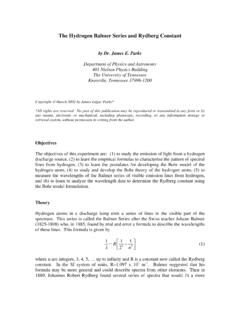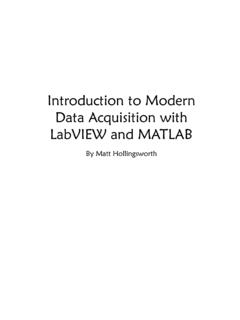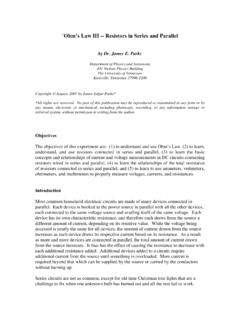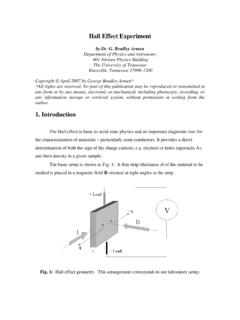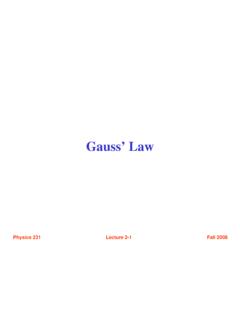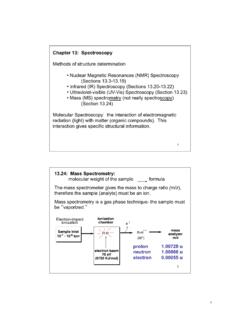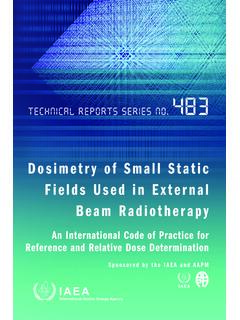Transcription of Attenuation of Radiation - University of Tennessee
1 Attenuation of Radiation by Dr. James E. Parks Department of Physics and Astronomy 401 Nielsen Physics Building The University of Tennessee Knoxville, Tennessee 37996-1200 Copyright March, 2001 by James Edgar Parks* *All rights are reserved. No part of this publication may be reproduced or transmitted in any form or by any means, electronic or mechanical, including photocopy, recording, or any information storage or retrieval system, without permission in writing from the author. Objectives The objectives of this experiment are.
2 (1) to study the interaction of Radiation with matter, (2) to study how charged particles interact with materials, (3) to study the 3 primary ways that gamma rays interact with matter, (4) to learn how materials are effective in shielding Radiation , (5) to learn some Radiation terms and parameters that affect the stopping power of Radiation , and (6) to measure Radiation Attenuation coefficients for beta particles and gamma rays. Theory There are two primary types of Radiation that originate from the nucleus of the atom, and these are charged particles and gamma rays.
3 Charged particles from radioactive sources consist primarily of alpha particles and beta particles. Alpha particles are doubly charged helium nuclei, and beta particles are negatively charged electrons. Alpha particles are emitted with a specific kinetic energy , but beta particles have a distribution of energies. The energy available for the creation of a beta particle is shared between the beta particle and a neutrino particle created simultaneously. Neutrinos are massless particles that interact with matter with a very low probability.
4 Alpha and beta particles interact with matter by their charges interacting with the outer electrons of atoms making up the material. Kinetic energy of the particle is transferred to the material by the particle exciting the electrons to higher lying excited states and/or by the particles ionizing the atoms and molecules, removing the electrons from the outer shells. This is easily understood by considering the electrical interaction that charges have with each other. Alpha particles are much heavier than beta particles, more than 7,000 times heavier, and at the same energy , move much slower than beta particles.
5 Hence, they have longer times to interact and to transfer their energy to the outer shell electrons. Also, they have Attenuation of Radiation twice the charge and the electrical interactions are therefore greater. As a result then, alpha particles have greater interactions and give up their kinetic energy much more quickly than do beta particles. Therefore, alpha particles have very short pathlengths in the material. The range of charged particles at a given energy is defined as the average distance they travel before they come to rest.
6 The range of a 4 MeV alpha particle in air is about 3 cm, and they can be stopped by a thin piece of paper or a thin sheet of some other solid or liquid material. 4 MeV beta particles have a maximum range of about 1,700 cm in air whereas they have a maximum range of about cm in water and about cm in lead. Figure 1 shows the maximum range of beta particles as a function of their energy for some selected materials of interest for this experiment. Figure 1. The maximum range of beta particles as a function of their energy for polyethylene.
7 The penetrating power of gamma rays is much greater than that of charged particles. They interact with matter in three primary ways: (1) by the photoelectric effect, (2) by the Compton effect, and (3) by pair production. Of these three, the photoelectric effect is the most effective. In the photoelectric effect, a gamma ray photon ejects an electron from an atom, transferring almost all of its energy to the electron by giving it kinetic energy . The energy of the gamma ray E supplies the energy Eb to free the electron from its bound state and to give it kinetic energy .
8 (1) -Kinetic EnergybEEe =+Revised 4/6/01 2 Attenuation of Radiation The binding energy is a few electron volts and is negligible compared to the energies of the gamma rays that may be on the order of a few million electron volts. The kinetic energy given the electron by the gamma ray then gives up its energy to the material in which it is located by interacting with the outer electrons of the atoms of the material. As with alpha particles and beta particles, the energetic electron excites and ionizes the atoms along its path until it loses all of its kinetic energy .
9 ()2011 11cosEE mc = eeScattered ElectronwithKinetic EnergyInitial Gamma RayEnergy = EScattered Gamma RayEnergy = EElectronatRest0 Figure 2. Schematic diagram illustrating Compton scattering. In the Compton effect, a gamma ray is scattered by an electron, and in the process, a portion of its energy is transferred to kinetic energy of the electron. The kinetic energy of the electron is then dissipated by it interacting with the material, by exciting and ionizing the atoms along its path. Whereas most of the gamma ray s energy is transferred to the electron in the photoelectric effect, only a fraction of its energy is transferred in the Compton effect.
10 The fraction of energy transferred depends on the Compton scattering angle and the initial energy of the gamma ray, E0. If the energy of the gamma ray before it is scattered is E0 and the energy of the scattered gamma ray is E, then E0 and E are related by the Compton scattering relationship (2011 11cosEE mc) = (2) where m is the mass of the electron and c is the speed of light. The scattering angle is the angle between the direction that the scattered gamma ray travels relative to the direction that the initial gamma ray was traveling.

